
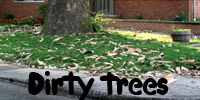
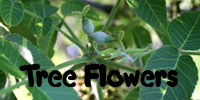
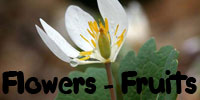
|
Flowers and Fruits, part 4: Pollination
For
a flowering plant to
become a fruiting plant, pollen must be transfered from a stamen
(preferably on another flower, on another plant), through a process
called pollination. Next,
a sperm cell from inside the lucky pollen grain must penetrate
an egg cell deep within in the pistil, thereby performing fertilization
of the egg. The resulting zygote (fertilzed
egg) will develop into an embryo plant --a seed.
Depending upon the plant species, facilitated by adaptive
modifications to encourage a particular type of pollination
vector, pollination is most often carried out by some type of
animal, such as a bee, a bird, a bat or
a butterfly. Or a moth. Of course, many plants are wind-pollinated
(including grasses, sedges, rushes, and many trees) and a very
few
(eel-grass, for instance) are water-pollinated.
Below, an elegant illustration of the process. The stigma is a very
special environment for a pollen grain, having the proper nutrients and
growth-stimulating chemicals to enable the grain to grow a long, hollow
hair-like extenstion called a pollen tube down
through the tissues of the style, eventually bursting into a
egg-containing ovule located inside the ovary
at the base of the pistil. Each pollen grain contains only two sperm.
In a special angiosperm-only phenomenon called "double fertilization,"
one of the sperm cells fuses with the egg while the
pathetically
unlucky other one fuses with two other cells in the
ovule,
giving rise to a nutritive tissue called "endosperm."
Endosperm is food
for the developing embryo or a newly-sprouted seed. Popcorn
is mainly puffed endosperm. Yum.
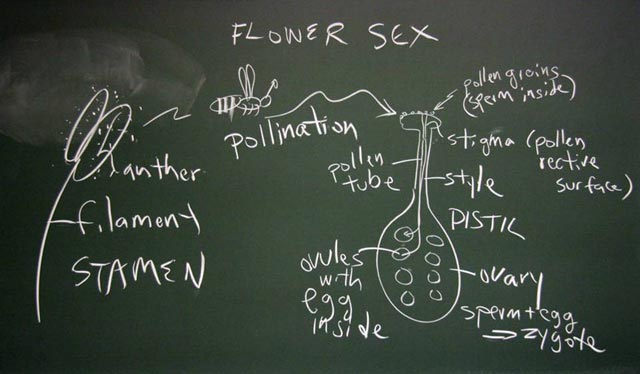
Blackboard sketch of "flower sex."
Below, common rose-mallow. This robust marsh perennial herb is
pollinated by two types of large bees. One of them is bumblebee,
generalists that visit a great variety of flowers. The other is a
specialist hibiscus bee, Ptilothrix bombiformis
(Anthophoridae). The hibiscus bee assiduously gathers copious amounts
of pollen with which to provision her below-gound nest.
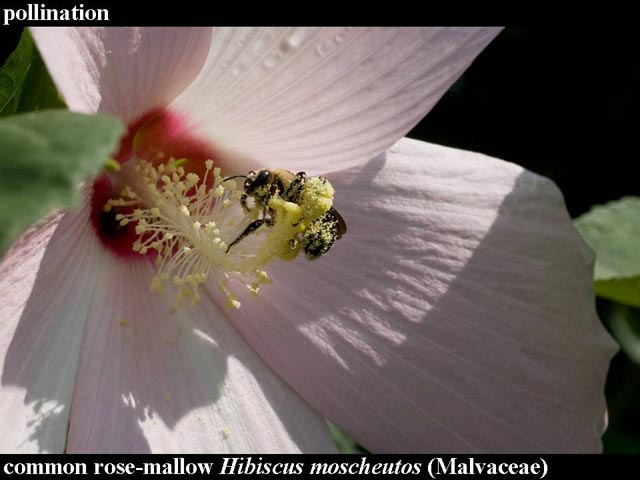
Hibiscus bee gathering rose-mallow pollen.
Below, a hibiscus bee
gathers pollen from a rose-mallow
blossom. Notice her first at another flower in
the background and that upon her arrival to the new flower, she touches the stigmas inconveniently placed in her flight path.
Hibiscus bee
pollinating rose-mallow blossom.
After pollination and
fertilization have occurred, some
or all of the
other parts --calyx, corolla, androecium and the stigma/style portions
of the pistil --may be shed. Within the ovary the ovule(s), each
contain a developing embryo. As they develop, the ovary
too ripens, sometimes assuming a fleshy form to elicit
consumption
by seed-dispersing animals. Thus a fruit is
a ripened ovary containing seeds.
Below, a rose-mallow fruit. It has opened (dehisced) to reveal the 5
section (carpels) of which it is composed and approx. 80 seeds. The
remnants of the calyx (sepals) are present but the other flower parts
are long gone. This type of fruit --a dry one, usually multi-seeded,
composed of 2 or more units (carpels) is a capsule.
The rose-mallow fruit
is a 5-chambered capsule.
Most pollination by animals is some type of mutualism in which both
parthers benefit. The pollinator gets food
--pollen and/or nectar -- and the plant receives a FED-EX-like
(UPS...United Pollen Service?) pickup and delivery service for pollen
grains.
If plants didn't pay for sex, there'd be no such thing as hummingbirds!
Usually, the plant - pollinator relationship is fairly flexible in that a
given pollinator can forage on a number of different plant species,
and a plant may have several different types of pollinators. An
exception to this pattern is the interesting and famous
exceptionally strict mutualism: the yucca - yucca moth
mutualism. The plant is pollinated only by one type (several
related species) of moth, while the moth is absolutely reliant on the
yucca plant to sustain its young.
Below, yucca. This is a eastern North American species that has been
introduced into our area, where it is frequently seen along railroad
tracks.
Yucca plants are
frequent along RR tracks.
Below, yucca flowers at
night late in June. The flowers don't produce nectar. Small anthers are
perched at the tip of filaments that are stout --well suited for a moth to grasp
on to. Small white moths flutter about, eventually settling inside
the bloosoms.
Yucca flowers and
yucca moths.
Below, a yucca moth gathering pollen. The moth's mouth
parts are specialized for both gathering pollen and storing it in a
ball under her chin. (Does a moth have a chin?) Soon afterwards, she
flies off to another flower on another plant.
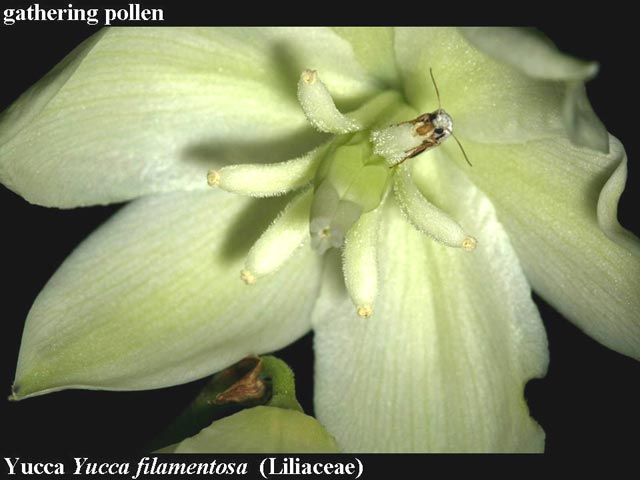
Yucca moth gathers
pollen from anther of yucca flower.
Below, oviposition.
Arriving at a new blossom, the moth performs oviposition (egg-laying)
by piercing the flower's ovary with the tip of her abdomen and
injecting several eggs into the ovary. The larvae that hatch from the
eggs will consume a portion of whatever seeds are developing inside the ovary.
But this is only an effective strategy if indeed seeds are developing inside, so
her next step is pollination of that flower.
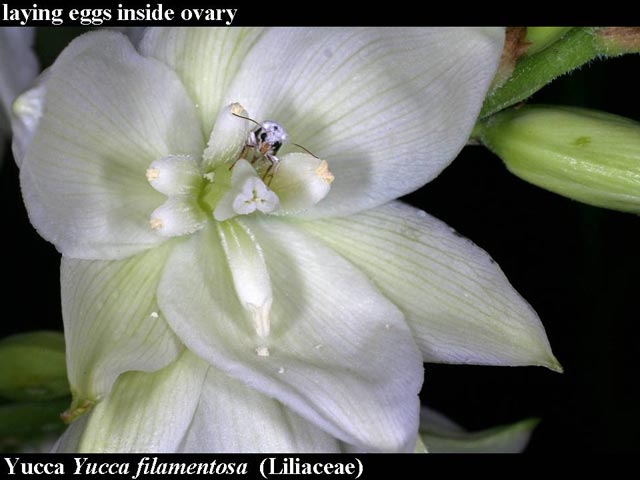
Yucca moth ovipositing.
Below, pollination.
After placing her precious eggs that are about to hatch into
an ovary, the moth would like to be more of a moth...she wants to be
mother. Hmm. To ensure that, the first act following oviposition is to
insert the ball of pollen previously gathered from another flower into
the specially shaped stigma, thus ensuring that her babies will have a
nice place in which to spend their childhood. She is a pistil-packing momma!
A pistil-packing momma!
Below, yucca fruits.
The moth's babies (larvae) consume some, but not all of the plant's
babies (seeds). Evebtually, late-stage larvae chew their way out of the ovary and burrow
underground where to pupate (form a cocoon) and over-winter.
Yucca fruits in late
autumn.
Back: Flowers&Fruits Menu
Next: Pistil Variation
|

